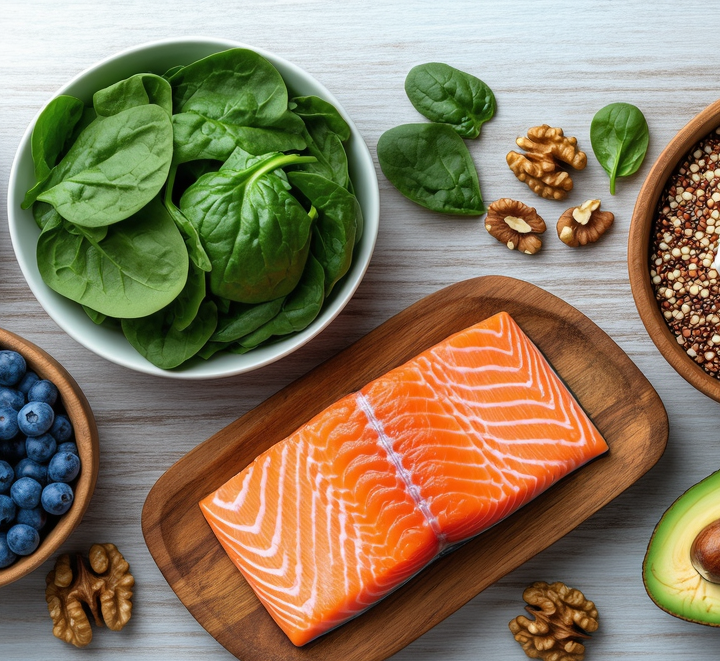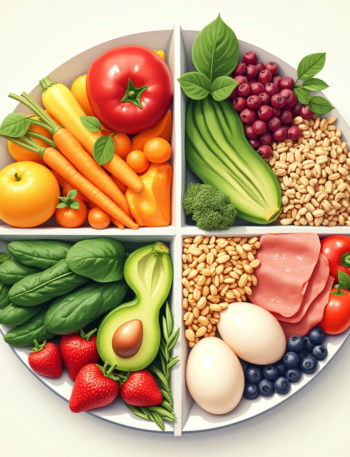In our quest for better health, the term “superfood” has become increasingly popular. These nutrient powerhouses offer exceptional benefits to our overall wellbeing, but many of us struggle with how to incorporate them into our daily eating habits. This guide will walk you through the essential nutrients your body needs and practical ways to include superfoods in your everyday meals.
Table of Contents
Introduction: The Foundation of Good Health
Our bodies are remarkable machines that require proper fuel to function optimally. This fuel comes in the form of nutrients – the compounds in foods that provide energy, support growth, and regulate bodily processes.
Nutrients fall into two main categories:
- Macronutrients: Carbohydrates, proteins, and fats – needed in larger amounts
- Micronutrients: Vitamins and minerals – needed in smaller amounts but equally crucial
Understanding these nutrients and their food sources is the first step toward making healthier choices and incorporating superfoods into your diet.
Macronutrients and Their Role
Carbohydrates: Your Body’s Preferred Energy Source
Carbohydrates provide the glucose your body needs for energy, particularly for brain function and physical activity. However, not all carbs are created equal:

Healthy Carbohydrate Superfoods:
- Quinoa: A complete protein source that’s also rich in fiber, magnesium, and iron
- Sweet potatoes: Packed with beta-carotene, vitamin C, and fiber
- Oats: Contain beta-glucans that help lower cholesterol and improve blood sugar control
- Berries: High in antioxidants, fiber, and vitamin C with a low glycemic index
How to Include Them:
- Replace white rice with quinoa in your stir-fries and salads
- Bake sweet potato wedges instead of regular fries
- Start your day with overnight oats topped with berries and nuts
Proteins: The Building Blocks of Life
Proteins are essential for muscle repair, immune function, and cellular growth. They break down into amino acids that the body uses to build everything from hair and nails to enzymes and hormones.
Protein Superfoods:
- Spirulina: A blue-green algae with complete protein content and numerous vitamins
- Hemp seeds: Contain all essential amino acids plus omega-3 fatty acids
- Wild salmon: High in protein and omega-3s with less contamination than farmed varieties
- Black beans: Offer protein, fiber, antioxidants, and various minerals
How to Include Them:
- Add spirulina powder to smoothies (start with 1/2 teaspoon and gradually increase)
- Sprinkle hemp seeds on salads, yogurt, or breakfast bowls
- Enjoy wild salmon twice weekly, baked with herbs and lemon
- Use black beans in tacos, soups, and as a base for veggie burgers
Fats: Essential for Brain Health and Energy Storage
Despite their bad reputation in the past, certain fats are crucial for brain health, hormone production, and nutrient absorption. The key is focusing on healthy fats while limiting unhealthy ones.
Healthy Fat Superfoods:
- Avocados: Rich in monounsaturated fats, fiber, potassium, and vitamins
- Extra virgin olive oil: Contains heart-healthy polyphenols and monounsaturated fats
- Chia seeds: Packed with omega-3 fatty acids, fiber, and calcium
- Walnuts: Offer plant-based omega-3s, antioxidants, and proteins
How to Include Them:
- Spread avocado on toast instead of butter
- Use olive oil for low-temperature cooking and salad dressings
- Make chia pudding for breakfast or dessert
- Add chopped walnuts to oatmeal or yogurt, or snack on them throughout the day
Micronutrients and Their Benefits
Vitamins: Small but Mighty
Vitamins are organic compounds that support countless bodily functions, from healing wounds to maintaining eyesight.
Vitamin-Rich Superfoods:
- Kale: An exceptional source of vitamins A, C, and K
- Blueberries: Loaded with vitamins C and K, plus antioxidants that support brain health
- Moringa: Contains vitamins A, C, E, and many B vitamins
- Cacao: Rich in flavanols and magnesium that support heart and brain health
How to Include Them:
- Make kale chips as a snack or add kale to smoothies
- Enjoy blueberries fresh, frozen, or as a topping for yogurt and cereals
- Mix moringa powder into smoothies, soups, or sauces
- Use raw cacao powder in smoothies, oatmeal, or homemade energy balls
Minerals: The Body’s Infrastructure Support
Minerals are inorganic elements that contribute to bone development, fluid balance, nerve transmission, and more.
Mineral-Rich Superfoods:
- Seaweed: Contains iodine, calcium, iron, and magnesium
- Pumpkin seeds: High in magnesium, zinc, and plant-based omega-3s
- Turmeric: Contains curcumin and manganese that support anti-inflammatory processes
- Lentils: Provide iron, zinc, potassium, and folate
How to Include Them:
- Add dried seaweed to soups or enjoy seaweed snacks
- Roast pumpkin seeds with spices for a mineral-rich snack
- Incorporate turmeric into curries, golden milk, or smoothies (add black pepper to enhance absorption)
- Use lentils in soups, stews, or as a meat substitute in tacos and pasta sauces
The Role of Water and Hydration
Often overlooked, water is perhaps the most important nutrient. It makes up about 60% of your body weight and is involved in every bodily function, from digestion to temperature regulation and toxin removal.

Hydration Superfoods:
- Coconut water: Natural electrolytes make it nature’s sports drink
- Cucumber: 96% water and rich in nutrients that help reduce inflammation
- Watermelon: 92% water plus lycopene, vitamin C, and potassium
- Herbal teas: Hydrating while offering various plant compounds
How to Include Them:
- Drink coconut water after workouts instead of sugary sports drinks
- Add cucumber slices to water for a refreshing drink
- Enjoy watermelon as a snack or in summer salads
- Replace coffee with herbal teas throughout the day
How to Maintain a Nutrient-Rich Diet
Creating a diet rich in superfoods doesn’t require a complete lifestyle overhaul. Here are practical strategies to gradually introduce these nutritional powerhouses:
The Rainbow Approach
Aim to eat fruits and vegetables in all colors of the rainbow each day, as different colors indicate different phytonutrients:
- Red (tomatoes, watermelon): Lycopene for heart and cell health
- Orange/Yellow (sweet potatoes, mangoes): Beta-carotene for eye and immune health
- Green (spinach, broccoli): Chlorophyll and isothiocyanates for cancer prevention
- Blue/Purple (eggplant, blueberries): Anthocyanins for cognitive function and heart health
- White (garlic, onions): Allicin compounds for immune support
Superfood Meal Planning
Breakfast Options:
- Smoothie bowl with spinach, berries, hemp seeds, and spirulina
- Overnight oats with chia seeds, cacao nibs, and walnuts
- Avocado toast on whole-grain bread with hemp seeds
Lunch Options:
- Quinoa bowl with roasted sweet potatoes, black beans, and avocado
- Kale salad with pumpkin seeds, berries, and olive oil dressing
- Lentil soup with turmeric and leafy greens
Dinner Options:
- Wild salmon with steamed broccoli and quinoa
- Stir-fry with colorful vegetables, seaweed, and brown rice
- Black bean tacos with homemade guacamole and vegetables
Snack Options:
- Apple slices with almond butter
- Homemade trail mix with walnuts, cacao nibs, and dried berries
- Chia pudding with cinnamon and fruit
Avoid Nutrient Depletion
Even the most nutrient-dense diet can be undermined by habits that deplete nutrients:
- Limit processed foods: They often contain ingredients that interfere with nutrient absorption
- Reduce alcohol consumption: Alcohol can deplete B vitamins and minerals
- Manage stress: Chronic stress increases nutrient requirements, particularly B vitamins and vitamin C
- Choose cooking methods wisely: Steam, bake, or lightly sauté vegetables instead of boiling, which can leach nutrients
Conclusion: Small Changes, Big Results
Incorporating superfoods into your daily meals doesn’t have to be complicated or expensive. Start with one or two additions to your regular meals, then gradually expand your superfood repertoire as you become more comfortable.
Remember that consistency matters more than perfection. A diet that includes a variety of whole foods—especially nutrient-dense superfoods—provides the foundation for energy, longevity, and disease prevention.
Take a moment today to assess your current eating habits and identify one superfood you could add to your meals tomorrow. Your body will thank you with improved energy, better focus, and enhanced overall health.
Your journey to better health through superfoods starts with a single bite. What will yours be?






[…] a prompt for kreai ai to design an image for this recipe ‘ Easy Overnight Oats Recipe ‘ Include this title in the center of the image ‘ Recipe Title ‘. makesure you […]